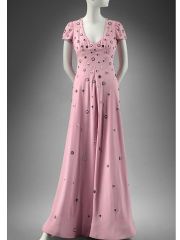Acetate rayon
Description
Highly oriented cellulose fibers produced from Cellulose acetate that has been saponified with caustic soda. Developed during the 1930s, acetate rayons are made by first producing cellulose acetate fibers from cellulose. Then the fibers are heated and stretched to aligned the cellulose acetate molecules. The final step is reconversion to cellulose in an alkaline solution. The properties of acetate rayon are similar to cotton. It has good dimensionally stability and is used in parachute ropes and fabrics, belting, hoses and balloon fabrics. It is often coated with rubber for tarpaulins and protective fabrics.
See rayon.
Note: Cellulose acetate was called rayon prior to 1951 and may have also been called acetate rayon.
Synonyms and Related Terms
acetato de celulosa saponificado (Esp.); rayonne (Fr.); acetaat rayon (Ned); saponified cellulose acetate; Fortisan [Courtaulds]
Physical and Chemical Properties
- Tenacity = 6-7 g/denier (dry); 5-6 g/denier (wet);
- Elongation = 6%;
- Moisture regain = 10.7%;
- Density = 1.5
- Cross section is irregular.
- Some lengthwise striations may be seen.
Comparisons
Properties of Synthetic Fibers
Resources and Citations
- G.S.Brady, Materials Handbook, McGraw-Hill Book Co., New York, 1971 Comment: p. 654
- J.Gordon Cook, Handbook of Textile Fibres:II Man-made Fibres, Merrow Publishing Co. , Durham, England
